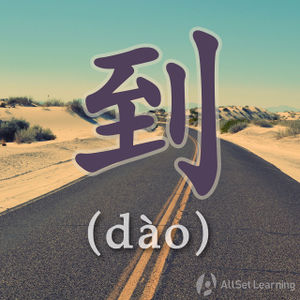Difference between revisions of "Result complements "-dao" and "-jian""
NFiorentini (talk | contribs) m (Added a space before the quotation mark and removed the space from after that quotation mark.) |
|||
| Line 3: | Line 3: | ||
Two of the most common result complements in Chinese are 到 (dào) and 见 (jiàn). On this page we're only going to be talking about verbs related to the senses ("see," "hear," etc.), and for this usage, the two are interchangeable. | Two of the most common result complements in Chinese are 到 (dào) and 见 (jiàn). On this page we're only going to be talking about verbs related to the senses ("see," "hear," etc.), and for this usage, the two are interchangeable. | ||
| − | == | + | == Verbs with 到 (dào) and 见 (jiàn) == |
=== Structure === | === Structure === | ||
| Line 50: | Line 50: | ||
</div> | </div> | ||
| − | == Negative | + | == Negative Forms == |
=== Structure === | === Structure === | ||
Revision as of 03:59, 23 May 2017
-
Level
-
Similar to
-
Used for
-
Keywords
Two of the most common result complements in Chinese are 到 (dào) and 见 (jiàn). On this page we're only going to be talking about verbs related to the senses ("see," "hear," etc.), and for this usage, the two are interchangeable.
Contents
Verbs with 到 (dào) and 见 (jiàn)
Structure
Result complements are a huge topic in Chinese grammar, but you can approach them in stages. The structure you come across the most is a verb with 到 (dào):
Subj. + Verb + 到 + Obj.
What 到 (dào) does is indicate that the outcome of the verb is achieved - what its result is. Without a result complement, the sentence would describe only the action itself. To illustrate, 看 (kàn) "to look" is the action of turning your head in a particular direction and focusing your eyes, whereas 看到 (kàndào), "to see," is the result of your brain taking in the visual input. It may sound a little hokey, but it really is possible to "look but not see," and Chinese makes a clear distinction between the action and the result.
The complement 见 (jiàn) is very similar to 到 (dào), and it is used in the same way:
Subj. + Verb + 见 + Obj.
However, there is a difference. 见 (jiàn) is generally only used after verbs involving one of the senses, like 听 (tīng) and 看 (kàn), whereas 到 (dào) can be attached to a large variety of verbs, which we will discuss at a higher level later.
Examples
- 你 看 见 那 个 帅哥 了 吗 ? Did you see that handsome guy?
- 你 看到 那 个 帅哥 了 吗 ? Did you see that handsome guy?
- 我 看 见 了 。 We didn't say what "I" saw; you have to infer it from the context. I saw him.
- 我 看 到 了 。 I saw him.
- 你 听 见 了 吗 ? Did you hear it?
- 你 听 到 了 吗 ? Did you hear it?
Negative Forms
Structure
Subj. + 没 + Verb + 到 / 见 + Obj.
This structure can be negated using 没 (méi).
Examples
- 你 没 看 到 那 个 帅哥 吗 ? You didn't see that handsome guy?
- 你 没 看 见 那 个 帅哥 吗 ? You didn't see that handsome guy?
- 我 没有 看 到 。 I didn't see him.
- 我 没有 看 见 。 We didn't say what "I" didn't see; you have to infer it from the context. I didn't see him.
- 你 没 听 到 吗 ? You didn't hear it?
- 你 没 听 见 吗 ? You didn't hear it?
See also
Sources and further reading
Books
- Short-term Spoken Chinese: Threshold Vol. 2 (汉语口语入门篇下) (p. 92) →buy
- Basic Patterns of Chinese Grammar (p. 109) →buy
- 40 Lessons for Basic Chinese Course (基础汉语40课上册) (pp. 205-6)→buy



